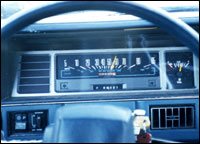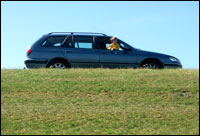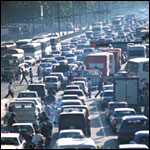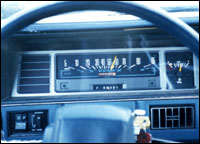Most of us don’t think much about car insurance. We eyeball the policy every year, fiddle around with a few changes to bring down the premium, and then forget about it until the bills come. And come they do — each exactly the same amount, no matter whether we’ve driven across the country or left the car in the garage.

Counting the miles.
Doesn’t sound right, does it? Mileage — like factors such as age and driving record — has long been correlated with accident risk. The more you drive, the higher the chance of a crash.
But unlike a driver’s age and record, how far you drive is not much of a factor in determining your premium. Some companies do offer low-mileage discounts, but these don’t come close to capturing the actual difference in accident risk between high- and low-mileage drivers. Todd Litman, director of the Victoria Transport Policy Institute in British Columbia, has done extensive research on the relationship between annual mileage and insurance claims. His studies suggest that if other risk factors — such as age of driver, time of day, and type of driving — are constant, then accident risk tends to increase in a roughly linear relationship with mileage. Translation: If you drive twice as much, you’re about twice as likely to have an accident.
The result is an inequitable insurance system and an incentive to treat driving like an all-you-can-eat buffet: Once you’ve paid the price, you may as well gorge — which increases the environmental and social problems related to driving. For starters, think of the three C’s: congestion, collisions, and climate change. Highways are becoming increasingly congested — according to the Texas Transportation Institute’s latest study, the average driver wastes 51 hours a year stuck in traffic, a four-hour increase in the last five years. Auto collisions are a leading killer of young people. And vehicles are a leading cause of air pollution and greenhouse gas emissions.
You Get What You PAYD For
The good news is that small changes in everyday activities, such as how we market and sell car insurance, could make a big dent in problems like these. Out here where I live and drive in the Pacific Northwest, the state of Oregon is taking a crack at lowering car insurance costs and reducing the collateral damage from driving. In July, Gov. Ted Kulongoski (D) signed a new law that encourages insurers to offer pay-as-you-drive insurance — or, in its acronym form, PAYD.

Jump on the pay-as-you-drive station wagon.
PAYD is an innovative approach to insurance that rewards motorists for driving less by selling insurance on a per-mile rate instead of a fixed rate. PAYD also incorporates existing rating factors, such as a driver’s crash history, age, and geographic location. Mileage can be checked either through high-tech satellite technology — GPS — or simple odometer readings. Essentially, pay-as-you-drive makes buying car insurance more like buying gasoline: The less you drive, the less you pay.
The Oregon bill, sponsored by the Oregon Environmental Council and widely supported by consumer, environmental, and business groups, helps insurers reduce the set-up costs for such a system by giving them a limited tax credit for offering per-mile premiums. It is purely voluntary: No mandates, just incentives. Now that the bill has become law, Oregon is the first state to give insurance companies a financial incentive to “test drive” per-mile premiums.
Getting this law on the books is a huge victory for Oregonians. First, if offered by insurance companies, PAYD will give consumers more control over their insurance costs — making it more affordable, for example, to insure a vehicle that is only driven a few thousand miles a year. The amount motorists could save with PAYD would depend on several factors, of course — including their insurer’s rate plan and their mileage — but data from a pilot project run by Progressive Insurance in Texas several years ago showed that participants saved an average of 25 percent.

These drivers should have left the car at home.
Second, the new pricing structure could spur motorists to drive less, which would reduce driving-related problems such as congestion and auto accidents. One study, by Aaron Edlin of the University of California at Berkeley, estimates that a universal system of per-mile auto insurance would reduce driving nationally by about 9 percent with a potential insurance savings of $8 billion a year and congestion-related savings of an additional $9 billion. Litman, for his part, estimates that PAYD would reduce driving by around 10 percent and crashes by 12 to 15 percent.
But the payoff for you, your family, and your community is not only that reduced driving would keep more dollars in your pocket, but also that it would help slash the huge environmental consequences — sprawl, air and water pollution, energy overconsumption, ruined wildlife habitat, drilling in places such as the Arctic National Wildlife Refuge — of America’s drive-through way of life. PAYD would even help address the problem of global climate change. As Dean Baker, codirector the Center for Economic and Policy Research in Washington, D.C., has noted, mileage-based auto insurance “may be the biggest free lunch around in reducing greenhouse gas emissions.”
The Oregon law also should serve to accelerate the work on similar programs in other states and countries. Efforts have been launched in Georgia, Massachusetts, and England, among other places. Texas has passed a bill authorizing insurers to offer PAYD, but Texas lawmakers did not offer incentives to insurers, which may be a key factor in getting the programs started.
If pay-by-the-mile insurance is as successful as its supporters in Oregon anticipate, the dynamics of the marketplace will take over, giving more consumers a chance to save money — and make the world a bit better — by spending less time behind the wheel.



